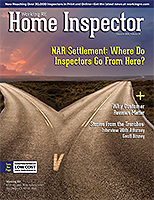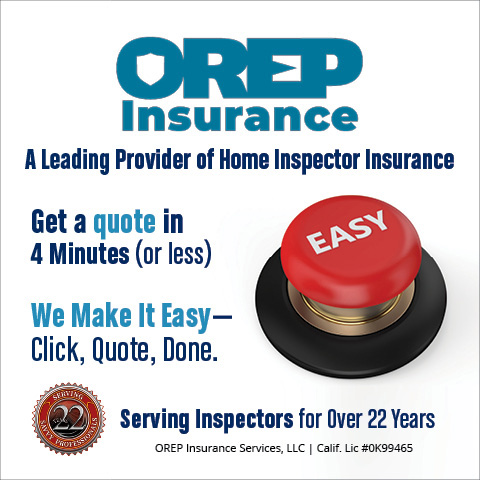 | > E&O/GL Insurance for Home Inspectors Competitive Rates, Broad Coverage, Free Risk Management, online inspection support for tough questions, discounts on education and more… Professional Coverage, Competitive Pricing Shop OREP today! |
The Backstory to Agent Disclosures: The Lawsuit That Started It All
by Isaac Peck, Publisher
As a home inspector, you’re probably familiar with the variety of disclosure paperwork that is shuffled back and forth between the buyer and seller during a property sales transaction. And it’s not just the seller who’s expected to disclose information about the property.
Though state law varies widely on the specifics, generally real estate agents have a duty to disclose known defects about a property to potential buyers (and face significant civil liability if they don’t!) AND they are often held liable for failure to disclose “reasonably discoverable defects.” In California, for example, a Realtor typically fills out the Agent Visual Inspection Disclosure (AVID) form which is designed so the agent can disclose the “material facts affecting the value or desirability” of the subject property.
While such disclosures are now commonplace—with many states having passed laws that require agents to disclose obvious material defects and hold them accountable for defects they should have known about through “reasonable diligence”—it wasn’t always like this.
Which begs the question: Where did our modern day disclosure and investigation requirements come from?
One of the most defining cases on this issue is Easton v. Strassberger, a lawsuit decided by the California Court of Appeals back in 1984.
Here’s a look at the history of the case and how it shaped the regulatory and legal environment that agents operate in today.
Massive Soil Movement
In 1976, the Strassburgers solicited the services of a real estate brokerage, Valley Realty, to help sell their home to Leticia Easton, the buyer in the transaction, for $170,000.
However, shortly after moving into the home in the summer of 1976, the parcel of land that Easton’s new home was built on experienced massive slides, with parts of the driveway being destroyed and the foundation being so damaged that the walls of the home cracked and the doorways were warped. This occurred, according to the experts, because a portion of the property was “fill” that had not been properly engineered and compacted.
The result was that although the home had appraised for $170,000 just a few months prior, new estimates placed the property’s value at just $20,000 and the cost to repair the damage caused and avoid recurrence were as high as $213,000. Not surprisingly, in December 1976, less than six months after moving in, Easton sued the Strassburgers and the real estate agents involved in the transaction for fraudulent concealment, intentional misrepresentation, and negligent misrepresentation.
Prior Knowledge
Unbeknownst to both Easton and the seller’s agents, the Strassburgers knew that there were serious soil issues affecting the property. There had been a minor slide in 1973 involving about ten to 12 feet of the filled slope, and another major slide in 1975 where the fill dropped eight to ten feet in a circular shape 50 to 60 feet across. However, the Strassburgers did not tell this to their agents (or the buyer!) or disclose the corrective action they had taken.
Judgment Passed then Appealed
Easton’s original case was tried in front of a jury that awarded her $197,000 in damages, to be paid from the parties as follows: five percent from seller’s brokerage, 65 percent from the sellers, and the remainder to be paid by the builders.
However, unwilling to accept liability in the matter (and perhaps worried about the precedent that would be set), the seller’s brokerage, Valley Realty, appealed the matter to the California Court of Appeals. Valley Realty made a variety of arguments, but perhaps most important was their contention that as a broker, they were “only obliged to disclose known facts and [had] no duty to disclose facts which ‘should’ be known to [them] ‘through reasonable diligence.'”
In other words, Valley Realty agreed that they were bound to disclose known facts, but objected to the idea that they were responsible for “conducting due diligence on the property,” which may or may not have identified the soil issues that caused the massive earth movements which nearly destroyed the home.
As the California Court of Appeals wrote, the court then had to decide whether “the broker’s duty of due care in a residential real estate transaction includes a duty to conduct a reasonably competent and diligent inspection of the property he has listed for sale to discover defects for the benefit of the buyer.”
(story continues)
Broker Due Diligence Established
Ultimately, the court found that the brokers’ duty to disclose material facts includes “the affirmative duty to conduct a reasonably competent and diligent inspection of the residential property listed for sale and to disclose to prospective purchasers all facts materially affecting the value or desirability of the property that such an investigation would reveal.”
In its decision, the court noted that the National Association of Realtors (NAR) Code of Ethics (at the time), indicated that its members had “an affirmative obligation to discover adverse factors that a reasonably competent and diligent investigation would disclose.”
NAR’s modern day Code of Ethics has been changed since then. The current requirement now reads:
Standards of Practice 2-1: REALTORS® shall only be obligated to discover and disclose adverse factors reasonably apparent to someone with expertise in those areas required by their real estate licensing authority. Article 2 does not impose upon the REALTOR® the obligation of expertise in other professional or technical disciplines.
However, the court reasoned that failure to hold a real estate broker responsible for “reasonably discoverable defects” would set a bad precedent and reward brokers for their ignorance. The court made a passionate argument for its position:
If a broker were required to disclose only known defects, but not also those that are reasonably discoverable, he would be shielded by his ignorance of that which he holds himself out to know. Such a construction would not only reward the unskilled broker for his own incompetence … If given legal force, the theory that a seller’s broker cannot be held accountable for what he does not know but could discover without great difficulty would inevitably produce a disincentive for a seller’s broker to make a diligent inspection.
The court also made clear that it expects more than a casual viewing of the property by an agent or broker, writing that because agents are held out to the public as professionals with “superior knowledge, skills and experience” in the field of real estate, they are expected the exercise their expertise and “should have been alert to the signs of soils problems.” As such, the court agreed with the original jury’s conclusion that a “reasonably diligent and competent inspection of the property would have included something more than a casual visual inspection and a general inquiry of the owners.”
Consequently, Valley Realtors was held liable for its failure to disclose a “reasonably discoverable defect” and the liability of the real estate agent/broker shifted substantially.
Liability and Birth of a Profession
Prior to this case, real estate had long operated on a doctrine of “caveat emptor,” which means buyer beware, and there was little recourse for buyers who purchased a home and later discovered major defects.
While state laws and legal precedents vary by state, the far-reaching effects of the Easton v. Strassberger decision in California should not be underestimated. The questions raised and the precedent established in California had a sweeping effect on agent practices, liability, and case law across the country.
Additionally, many cite Easton v. Strassberger as the catalyst that propelled the home inspection profession into existence (For more on this topic, click here to read more). There were some home inspectors in operation throughout the 1960s and 1970s, but it was not commonplace to order a home inspection prior to purchasing a property.
However, this case not only increased the responsibility and liability of real estate agents, but also led to the realization that agents and brokers could (1) better serve their clients and (2) reduce their new liability, by referring independent inspectors to provide a complete and thorough inspection of the property.
In this way, agents realized that they could manage the new liability placed on that due to the Easton v. Strassberger case by encouraging the buyer to hire an independent home inspector, who most likely was much more competent and qualified to inspect the property for defects.
In the face of potential lawsuits for what the real estate agent “should have known,” encouraging the buyer to hire a home inspector is now a common risk management practice for agents, according to Christy Andersen, Senior Agent at OREP, a leading provider of E&O insurance for real estate professionals nationwide.
“When we look at claims against agents and brokers, failing to have a home inspection on a property definitely increases the chance of a lawsuit down the road. In fact, our insurance carrier has identified this as a key risk management factor to the point where if a real estate agent doesn’t get a home inspection on their transactions (or get a signed home inspection waiver), they will actually pay a slightly higher premium due to the increased risk of claims,” reports Andersen.
One year after the Easton case was decided by the California Court of Appeals, Texas became the first state to regulate home inspectors and pass a home inspection licensing law. Other states followed and now more than 30 states have home inspector licensing laws, with many remaining states exploring options on how to regulate the profession.
So if you ever wondered how home inspectors came to be involved in over 90 percent of real estate transactions in the United States, now you know!
About the Author
Isaac Peck is the Publisher of Working RE magazine and the Senior Broker and President of OREP.org, a leading provider of E&O insurance for savvy professionals in 49 states and DC. Over 13,000 professionals trust OREP for their E&O. Isaac received his master’s degree in accounting at San Diego State University. Reach Isaac at isaac@orep.org or (888) 347-5273. CA License #4116465.
OREP Insurance Services, LLC. Calif. License #0K99465


